Introduction: Concern After the Myanmar Earthquake News
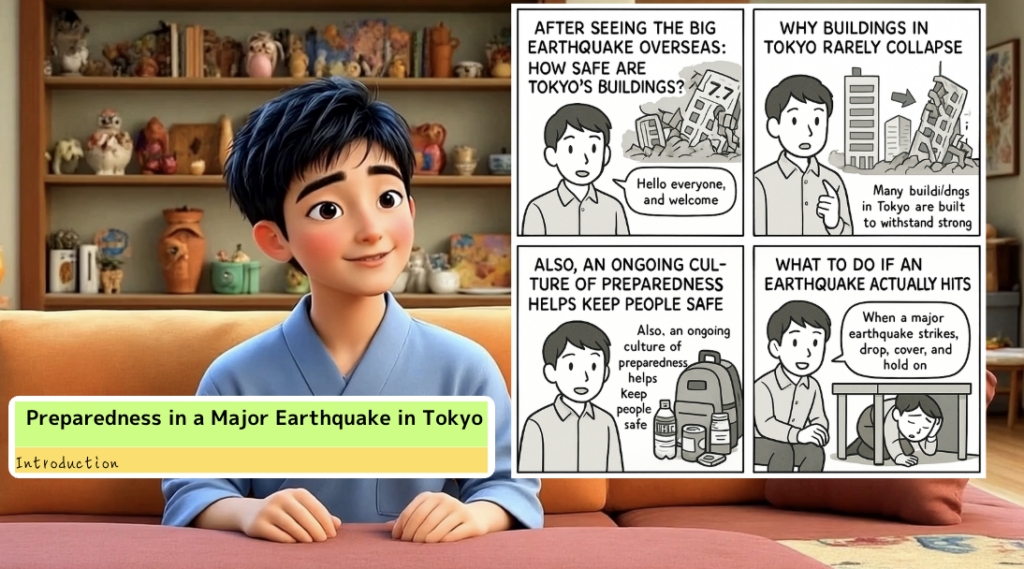
Hello everyone, and welcome. Recently, a magnitude 7.7 earthquake struck central Myanmar, resulting in severe damage and even the collapse of some tall buildings. If you are from overseas and currently living in or visiting Tokyo, you might have seen those images and felt concerned about whether similar disasters could happen here in Japan. It’s no secret that Japan is known as an earthquake-prone country, so it’s completely understandable to be worried.
However, many people are surprised to learn that in Tokyo, large-scale building collapses are actually quite rare, even when powerful quakes occur. This video aims to reassure you by explaining how Tokyo’s buildings are constructed to withstand earthquakes, how Japanese people incorporate disaster preparedness into their daily lives, and what immediate steps you should take if a significant earthquake—and possible tsunami—actually strikes.
Why Buildings in Tokyo Rarely Collapse
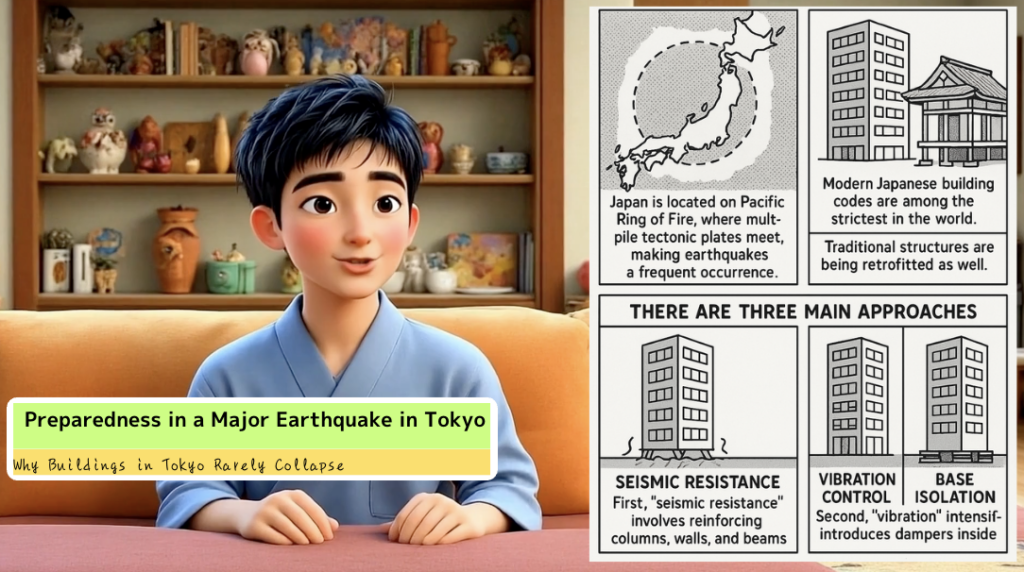
Japan is located on the Pacific Ring of Fire, where multiple tectonic plates meet, making earthquakes a frequent occurrence. Over the centuries, Japan has suffered devastating quakes, but each disaster has also led to improvements in both building technology and legal regulations.
Modern Japanese building codes, especially those revised in 1981 and again around 2000, are some of the strictest in the world. New constructions are required to meet high standards that anticipate tremors of intensity level six or seven on Japan’s seismic scale. Traditional structures are also being retrofitted, thanks to government incentives that encourage installing stronger beams, reinforced walls, or upgraded foundations.
When we talk about quake-resilient engineering in Japan, there are three main approaches. First, “seismic resistance” (often called a ‘taishin’ structure) involves reinforcing columns, walls, and beams so that the building itself can endure powerful shaking. Second, “vibration control” (or ‘seishin’) introduces special dampers inside the frame so that violent shaking is absorbed before it impacts the entire building. Third, “base isolation” (or ‘menshin’) uses layers of rubber and metal to decouple the structure from ground motion, significantly reducing transmitted shock. These techniques, either alone or in combination, explain why Tokyo’s high-rise buildings rarely collapse even when large earthquakes occur.
How Japan Prepares on a Daily Basis
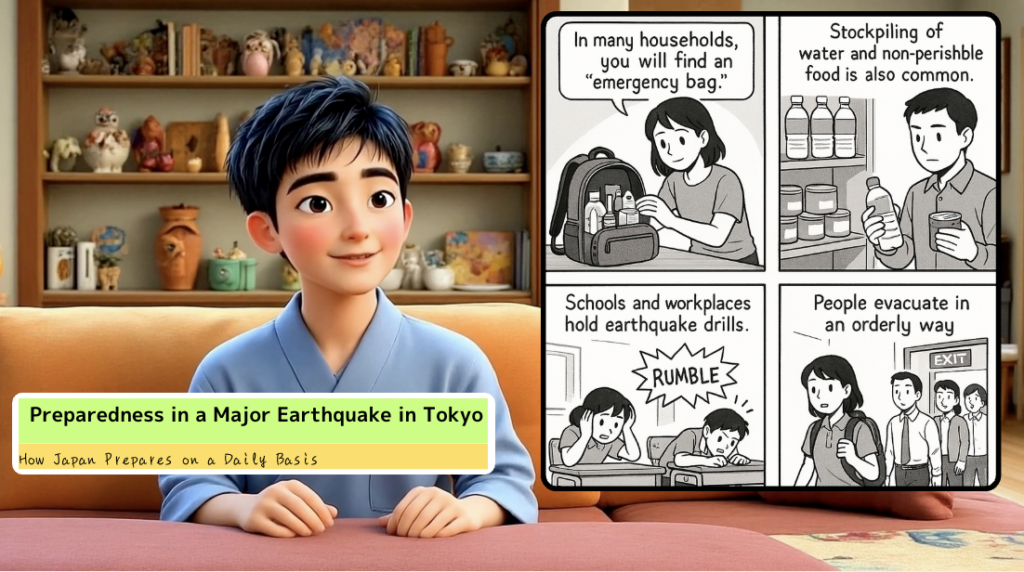
It’s not just about buildings. Because earthquakes can happen at any time, Japanese society takes a proactive stance toward disaster readiness. This ongoing culture of preparedness helps people respond calmly and effectively under sudden stress.
In many households, you will find a dedicated “emergency bag” or go-bag. This is typically a backpack that contains essential items such as bottled water, preserved foods like crackers or canned goods, flashlights, a portable battery or power bank, first-aid supplies, and copies of important documents. The idea is that if you need to evacuate immediately, you can simply grab this bag and have enough resources to keep you safe and nourished for at least a short period.
Additionally, it is common to maintain a stockpile of water and non-perishable food for at least three days, and preferably up to a week. Many people use the “rolling stock” approach, where they regularly consume and replace items so that the emergency supply remains fresh. Schools and workplaces in Japan also hold annual or semi-annual drills, ensuring that if an actual earthquake strikes, people know exactly what to do: from taking cover under desks to evacuating in an orderly fashion when the shaking stops.
What to Do If an Earthquake Actually Hits
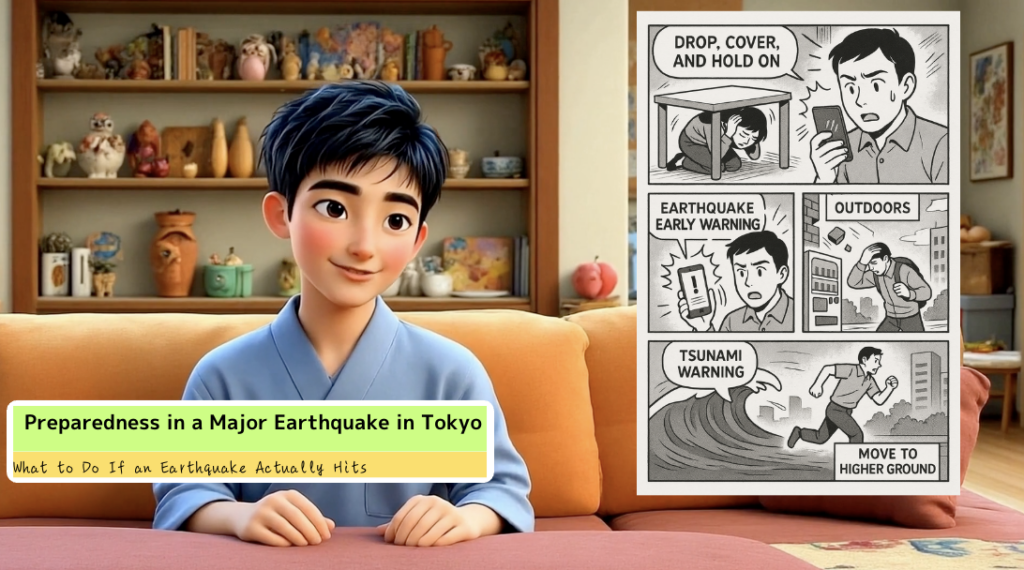
When a major earthquake strikes, your immediate reactions matter. A good principle to remember is “Drop, Cover, and Hold On,” which translates into lowering your body, protecting your head, and remaining under a sturdy table or desk until the strong shaking subsides. Large furniture or objects may topple over, and items could fall from high shelves or walls, so protecting your head and neck is crucial. If you rush outside during violent shaking, there is a risk of being struck by falling signs, windows, or debris.
In Japan, many people rely on the Earthquake Early Warning system. A distinctive alarm may sound on televisions and smartphones a few seconds to tens of seconds before a big quake’s strongest tremors arrive. If you hear this alarm, quickly look for a secure spot, cover your head, and remain aware of your surroundings. While it might only provide a brief warning, these precious moments can reduce injury by allowing you to brace yourself or move away from large windows.
If you are outdoors, stay alert for hazards such as glass, concrete, or vending machines that could topple or break. Ideally, move away from buildings if you can do so quickly and safely, and use a bag or jacket to shield your head from potential falling objects. If you are in a train or subway, it will likely make an emergency stop. Stay calm, hold on to rails or straps, and wait for announcements from the conductor or station staff, rather than trying to pry doors open.
One important point to consider, especially if you are near the ocean or by rivers, is the risk of a tsunami following a large offshore earthquake. Although central Tokyo is somewhat shielded by the bay and protective infrastructure, there are low-lying coastal areas where tsunami waves could pose a threat in a very large quake. Local authorities will issue tsunami advisories or warnings—often in multiple languages, especially for well-known tourist locations. If a tsunami alert is broadcast, do not stay near the water. Move immediately to higher ground or to a taller, reinforced building. Even a modest-sized wave can have severe force, so follow official instructions and evacuate quickly if the warning is serious.
After the Quake: Staying Safe and Informed

Once the shaking subsides, remember that aftershocks may continue for hours, days, or even weeks. Remain vigilant about your immediate environment, check if water, gas, and electricity are functioning correctly, and watch for any signs of fire. In dense urban areas like Tokyo, transportation might come to a halt temporarily, leading to a situation known as being a “stranded commuter.”
If trains are not operating, it may be wiser to remain in a safe, secure place and wait for official guidance rather than attempting to walk long distances at night. Conbini (convenience stores) or large retail complexes sometimes serve as temporary rest points—referred to as “disaster support stations”—providing water, bathrooms, or basic information. Local governments also identify certain schools, community centers, or other public buildings as shelters or assembly points. Keeping a charged phone or spare battery can help you stay informed through apps such as “Safety tips,” provided by the Japan Tourism Agency, which sends push notifications in multiple languages about earthquakes, tsunamis, and other emergencies.
Be sure to verify any social media rumors via official sources like NHK World or local government websites before relying on them. In large-scale disasters, false information can spread quickly. Relying on official announcements or trusted multilingual channels—such as embassies, city office websites, or recognized news outlets—will help you make the safest decisions.
Conclusion: Building Confidence Through Preparedness
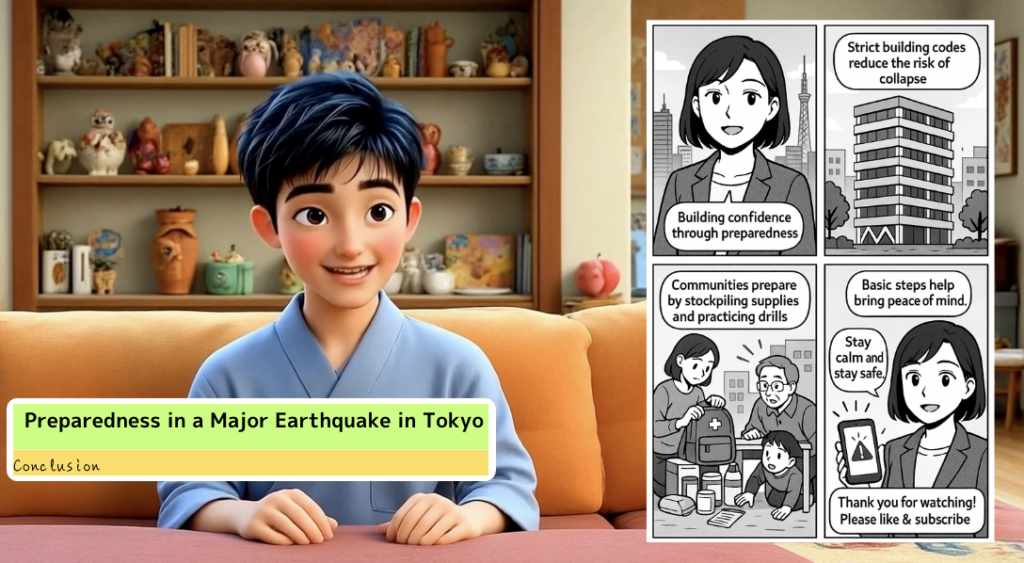
All things considered, living with the threat of earthquakes is a reality in Japan, but there is a remarkable level of preparedness woven into everyday life. The strict building codes and advanced engineering (featuring seismic resistance, vibration control, and base isolation) mean that dramatic collapses are far less likely than you might fear. Communities also prioritize preparing emergency kits, stockpiling supplies, and practicing drills so that people can respond promptly and effectively if the ground starts to shake.
If you ever find yourself worrying about whether you could handle a large quake, remember that knowledge and a few basic preparations can go a long way. Ensuring you have a small store of food and water, keeping an emergency bag near the door, and installing multilingual disaster apps on your phone are all small steps that bring peace of mind. Above all, staying calm in the face of sudden tremors, protecting yourself first, and following official instructions—especially regarding potential tsunamis near coastal areas—will significantly increase your safety.
Thank you for watching. I hope this video has helped ease any concerns you might have about earthquakes in Tokyo, especially after seeing dramatic footage of disasters overseas. If you found this information useful, please consider liking this video and subscribing to the channel for more content on staying safe and enjoying life in Japan. Take care, stay prepared, and see you in the next video!


